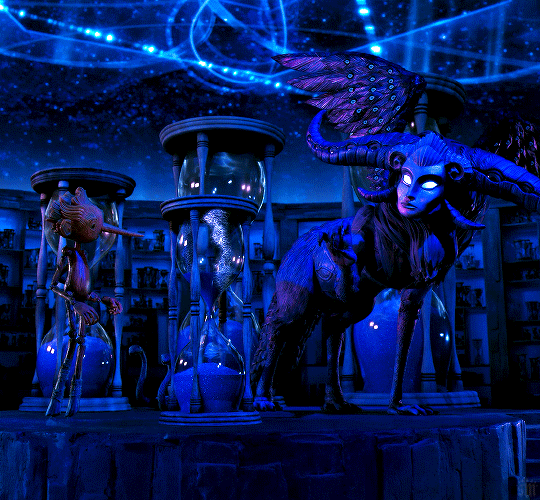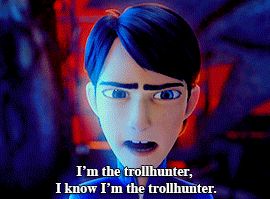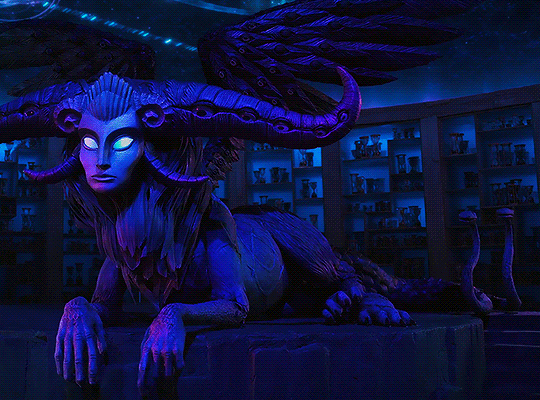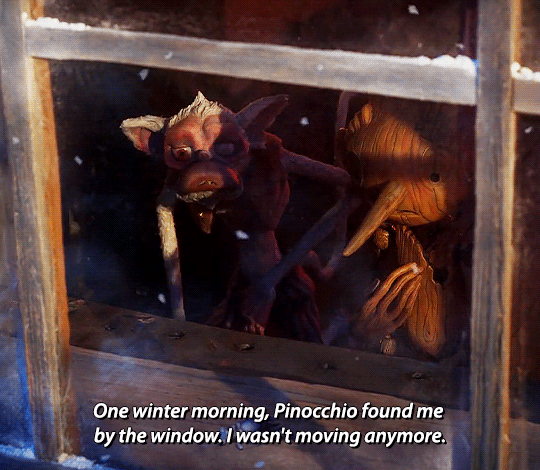originally posted at https://canmom.tumblr.com/post/705004...
Happy almost-new Gregorian year everyone!

No huge introduction tonight since it is late and I imagine Guillermo del Toro needs little introduction in these parts, and for biography, I would be paraphrasing Wikipedia’s quite thorough article. I also have seen fewer films of his than I’d like, so I could give you only broad strokes: he has a deep and very genuine enthusiasm for gothic horror monsters and comics, he likes to tell metaphorical stories about fascism framed through fairy tales, he’s really big on body horror.
Here’s the really condensed version. del Toro got his start on horror movies, made his name on comic book movies Blade II and Hellboy 1 and 2, helping to revive the genre, and through that he got enough clout to increasingly do original films like El laberinto del fauno (Pan’s Labyrinth) and The Shape of Water which fit the del Toro ‘sympathetic or alien monsters contrasted against fascism’ template, Pan’s Labyrinth especially being the iconic del Toro movie; two gothic horror type movies Crimson Peak and Nightmare Alley; and odd duck Pacific Rim, a gleefully silly spin on mech anime. And I’m a little embarassed to say that I’ve only seen Pan and Rim. I’d rather wait to say more until I’ve filled in the rest.
But I will briefly talk about animation, since it’s Animation Night! Although he began as an eight-year-old with a Super 8 camera, Del Toro was interested in using animation from very early on, originally planning to create his first feature film Cronos as a stop motion film until his studio was robbed. He worked for a long time in special effects makeup, and most of his films have had an animation component, often blended with practical effects. With Hellboy, del Toro deep inspiration from Ray Harryhausen’s stop-motion, and asked Tippett Studio (the studio founded by Phil Tippett of Mad God) to make the miniatures and puppets, but I’m not sure if he used stop motion there. Pan’s Labyrinth using elaborate animatronics, The Shape of Water touching up a suit with CGI. Pacific Rim mostly shot its action scenes in CG at ILM, with Del Toro asking them to use a saturated colour and draw inspiration from Hokusai(!) in the wave effects.

Oddly enough, Pinocchio is not the first time del Toro has made a fully animated something. That is actually a series of CG TV shows animated by Dreamworks, the Tales of Arcadia series. It begins with the urban fantasy Trollhunters (not to be confused with the Norwegian fantasy mockumentary), followed by the sci-fi fish-out-of-water 3Below and time-travel Arthurian isekai Wizards (not to be confused with the Bakshi film).
Del Toro is credited as the ‘creator’ on all three series, which turns out to mean he originally planned it as a live-action TV show, which he turned into a book - a book which got picked up for a film by Dreamworks, and then finally evolved into a TV series. I’ll admit, I haven’t really looked into this much more than that, but it’s apparently scooped up a lot of praise and many awards.
OK, so, enough preamble, Pinocchio then. It’s a famous novel from 1883 by Italian writer Carlo Collodi. I suspect you know how it goes, at least in the broad strokes: puppetmaker Gepetto creates a living puppet, but he wants to be a real human boy; he becomes a serious troublemaker, and gets cursed for it, famously with a nose that grows whenever he tells a lie. Like most novels of the time, The Adventures of Pinocchio was first serialised in a weekly magazine, before getting compiled into a massive volume compiling all of Pinocchio’s many misadventures. (I think it’s interesting how serial fiction is making a big comeback lately, but more on that elsewhere.) In the first part of the serialisation, it ends with… Pinocchio getting executed by hanging, I’m not even kidding, it was supposed to be a ‘be moral’ tragedy. However, if I’m reading the summaries right, Collodi decided to retcon this and serialise it into something longer.
There’s a lot of Pinocchio-related things coming out right now. Disney are continuing their pattern of tedious expensive CGI remakes of their early traditionally animated movies, there’s an upcoming Souls-like game Lies of P, and there’s even a Russian animated film Pinocchio: The True Story. I couldn’t begin to tell you what kicked off this Pinocchio fever, since the book has been in the US public domain since 1940 - not coincidentally when Disney’s first adaptation came out. I was a little tempted, not gonna lie, to do a night where we watch all of them, but I don’t think I could sit through that lmao.

I showed Disney’s original Pinocchio on Animation Night before. By virtue of its position in history, and the ludicrously complex animation, it has positioned itself as the definitive filmed Pinocchio - the one that all subsequent adaptations must in some way respond to. For more on that, read Animation Night 84: The Walter Dismey.
Funnily enough I actually I fell asleep during that one (I was very tired that day and in a very cosy place…), so I’m actually going to watch it again. It is relevant, because that Disney film was part of del Toro’s inspiration. He set out to make his Pinocchio as far back as 2008, describing it as a lifelong passion project, and that he appreciated what he called horror-movie like aspects of the original as well as the traditional animation. Wanting to set his one apart, del Toro stumbled on the designs of illustrator Gris Grimley, and hired him. Along with Grimley, he found a co-director in Mark Gustafson, a stop motion animator who’d worked with Wes Anderson on Fantastic Mister Fox and evidently had some experience with working with normally live-action directors. Later cam art director Curt Enderle from Laika and usual collaborator del Toro Guy Davis to design characters; the models were built over here by a specialist company called Mackinnon & Saunders. For more see here.

One of the things that interests me reading about it is that the animation is described as being very naturalistic, with a lot of attention paid to blinking, shifts of gaze, and that kind of thing. That sounds like a fascinating angle to bring to stop motion, and I hope I’ll have the energy to write about it after the film. Narratively, I’ve avoided learning too many spoilers, but I know it involves an ‘Italian youth training camp’ so I think I can guess how that’s going to play given del Toro’s usual themes. But we’ll see! I’m told there might even be songs.
I think that’s all I want to write tonight. So here’s the plan! We’ll take another, more wakeful go around OG Disney Pinocchio (1940), and then dive into the exciting new flavour of anti-fascist stop motion Pinocchio (2022).
post-watch
Disney’s Pinocchio, viewed for the first time with adult eyes, is a strange movie. The animation is lavish - the water, especially, Elemental Magic was right. I have thought the bar for water animation is pretty high after films like Children of the Sea, but the particular way of handling it in Pinocchio was something special - it’s not merely the familiar movement of unreasonable numbers of droplets, and the foam and spray is probably the weakest part, but the body of the water, moving shapes in a way that unambiguously captured the feeling of a flowing fluid, sloshing waves - that was fucking unbelievable. it was hard to believe human hands had animated that.
But, as a movie, what was going on lmao. I mean, I understand what was going on, it was a Disney movie animated during the late 30s. At that time, the sort of stories expected in a movie were very different, and Disney was pretty much laying down the first stones on what a feature-length animated movie should be like. So, an episodic structure, subplots that start and stop rather abruptly, a large amount of screen time devoted to extended scenes of spontaneous dancing. Character beats just kind of happen: Pinocchio is informed that he should want to be a ‘real boy’ almost the second he is awakened. Gepetto’s absent-mindness is played for jokes, but he mostly seems to take having a new puppet son in stride, and eagerly sends him off to school. It’s hard to tell how much of this is adapting a rather meandering serial novel, how much is Disney’s need to bowlderise the material, and how much is just that’s how they did films back then.
Del Toro’s version - which is astonishingly beautifully animated, more on that in a minute - starts off by hitting a lot of the beats from the Disney version but giving them a lot more context and motivation. Gepetto is now grieving a son killed in the first world war, and his creation of Pinocchio is a spur of the moment act of madness after he’s been drunken for like twenty years. The fairy that takes pity on him thus has a much stronger reason to help than ‘oh you asked nicely, Some Guy’. His reaction to Pinocchio manifesting in his house and singing a song is a more understandable terror. Even the talking cricket - here Sebastian J. - is someone who has physically taken up residence in Pinocchio’s heart before he gets the job as moral guide.
Later beats follow a similar pattern. When the circus master Count Volpe threatens Pinocchio and tells him he will be forced to perform until he wears out and then burned, it comes much later in their relationship as a plausible outburst when Pinocchio is already rebelling. When Pinocchio is ordered to go to school, it is an order given by the Podestà, the film’s avatar of fascism, rather than a spontaneous, assumed self-explanatory decision of Gepetto and the Fairy (stay in school kids!). Gepetto is angry that Pinocchio disobeys him about school not because of the ultimate moral importance of school, but because he’s being threatened by the fascists.
It’s a little tricky to tease out what’s responding to the Disney version, and what’s simply a new interpretation of the book. Many of its initial surprising elements, like the undertaker/psychopomp rabbits, actually do come from the book (where they’re invoked by the fairy as a threat). Others, like the sphinx who resurrects Pinocchio when he dies, are completely del Toro original. The giant sea monster, that Disney made a whale called Monstro, is here a giant dogfish as in the book, though it performs an almost identical role.
On all these fronts, the movie succeeds wonderfully, creating a recognisable Pinocchio story that’s just a little more grounded, the metaphors adjusted to del Toro’s preferred tastes. But then, hmm.
In the book, and Disney’s film, Pinocchio is tempted with vice alongside his friend Candlewick, unaware that this will lead to him being turned into a donkey and enslaved, which is a really hardcore worldbuilding detail lmao. In del Toro’s film, this temptation subplot sees Pinocchio going to a fascist soldier training camp. He naively participates in the fascist training makes a bond with Candlewick over ‘having a shitty dad’; Candlewick’s fascistdad the Podestà attempts to have Candlewick kill Pinnochio after they agree to draw in a training exercise, then moves to shoot Candlewick instead when Candlewick disobeys, only to be abruptly killed off by a bomb. More on that later.
The whole ‘it’s in facsist Italy’ thing is the element of the film I was most anticipating, since it’s a del Toro film and ‘antifascist metaphor’ is kind of his main deal, and… honestly I’m a little nonplussed. It doesn’t beat around the bush with fascistdad praising his son as healthy and ‘virile’ and the priest and the fascist being thick as thieves, and while the Podestà is a bit one-note, it fits the sort of fairy tale/parable story the film is telling. It’s clearly driving somewhere as Pinocchio’s puppet show turning into military songs, drawing a very direct link between the circus owner (who pines for lost glory days while performing in the remains of a Roman amphitheatre) and Mussolini. Fascism is clearly a Theme, nay, a THEME.
But this plot… kind of terminates abruptly without exactly resolving. Pinocchio and Candlewick form an alliance, there’s about to be a showdown, and then a bomb blasts Pinocchio away to have a resolution with Volpe, who we’d otherwise have thought to be shot by Mussolini. We briefly see Candlewick long enough to confirm he’s alive but he never appears in the movie after that. The Podestà is killed in the explosion.
Afterwards… Volpe’s monkey Spazzatura betrays his master, and Volpe gets a Disney death, while Pinnochio is briefly tied to a cross in a strange invocation of Jesus imagery. The main villains resolved, we press on to the whale sequence.
Now, we can always write counterfactuals. I don’t know what script revisions they tried along the way. But to me it seems that a plausible resolution for this plot would be to drop the return of Volpe, and for Candlewick to shoot his dad instead of Pinocchio. That’s essentially the same beat as Spazzatura attacking and killing Volpe on Pinocchio’s behalf, but it’s closer to the father/son central theme, and Candlewick as a mirror of Pinocchio. We already have some very clear Messages, e.g. that you should physically break ‘rules’ as represented by the hourglass, or that it’s right to tell lies in some circumstances when Pinocchio uses his extending nose to get out of a whale. So if we want to be really on the nose about it, and this film generally does seem to prefer to be on the nose about it… ‘shoot your fascist dad before he shoots you’? That said, it would be a larger escalation than what Pinocchio does later, so maybe that doesn’t really work.
Or if you would prefer something super tragic and fucked up, we could see Candlewick forced into a position where he has to kill himself rather than Pinocchio, and then Pinocchio is left with the banner from the silly little war game and the Podestà realises what happens and awkwardly congratulates Pinocchio on his victory and then goes away and shoots himself. Heavy-handed moral this time: “Fascism leads to nothing but pointless self-destructive tragedies.” Then again, that’s more of an Anno plot than a del Toro plot. I think that’s sorta what happens in Pan’s Labyrinth? It’s been a while though.
I admit, my ideas are kind of stupid and grimdark, so it’s probably for the best I’m not in charge of films. I still do feel the ‘bomb out of nowhere’ is a cheap way to avoid resolving the question of ‘who shoots whomst’.
Similarly, the film’s ending walks a rather fine line between an easy happy ending like the Disney version and something a bit more bittersweet. Pinocchio chooses to become mortal to save Gepetto (filial piety win!), and accordingly dies, but conveniently Sebastian has a wish he can use to save him according to fairy rules. Thus we finally fire the Chekhov’s gun that the immortal Pinocchio will outlive his family, but it’s fine, because they basically all live long and happy lives.
It’s not a bad ending by any means, ties up a lot more themes… but while we’re playing with counterfactuals? I imagined it ending right at the point where Gepetto is crying on the beach with the dead Pinocchio in his arms a la End of Evangelion, realising he should have accepted him when he was alive. Or maybe we continue a bit further, and we see Gepetto building more puppets, but none of them come alive - yes I’m definitely ripping off the trope of the monk carving thousands of Buddhas here which we saw in Asura last week lmao. I’m not saying this would be better than the actual ending, honestly it would be kind of pointlessly grimdark and not really say anything, so it would be a pretty shit ending when the shock wears off… but idk, ‘they lived happily ever after for the rest of their days’ doesn’t really do it for me either.
These counterfactual games aside… what an absolutely gorgeous fantastic looking movie. The animation is so rich in character, the puppet rigs so advanced, the lighting so perfect. Laika have been outdone. Modern computer-aided stop-motion has reached a level now that’s hard to comprehend.
The making-of documentary was interesting, mostly for the brief glimpses we got of design sheets and animation process. I loved seeing the huge miniature sets, and the giant Pinocchio model used for interactions with Sebastian. Although brief, we got to see some of the storyboards and expression sheets, and hear del Toro talk very thoughtfully (if briefly) about naturalistic acting in animation.
I don’t know all the details, but given this is animation to match a recording, I assume the scenes were roughed out in traditional animation before any commitment to moving models. Since stop motion animation is essentially forced to be straight-ahead, this is the only way I can think to time out the acting in a way that makes sense. They also made pretty heavy use of video reference to nail the acting. There’s a large block of the credits under ‘roto’, though I think that may actually be painting out armatures rather than direct rotoscopy.
Sadly not at all addressed were all the water scenes, which is a shame, since I really wanted to know how they were done: the water has this curious sheen to it that makes it look like it’s some sort of physical model-scale material, and there’s all sorts of tiny particles in a way that seems to me to suggest the famous Disney water animation. So we thought, are they doing some sort of ridiculously complex technique with gels, at least in some shots? The answer turns out to be… no they are not, it’s ‘just’ CG. But a cool use of CGI that managed to make me wonder!
The animation process here is not exactly ‘pure’ stop motion where each frame is essentially unaltered beyond removing armatures - instead, it seems most shots are composites of multiple photos with different lighting, and combined with digital matte paintings and effects. For example, in a scene with a flaming torch, a photo would be taken with just the LED torch light, allowing the relative contributions of light sources to be adjusted in post. The fire effects appeared to be physical, and looked really nice, although they came in all the movie’s most tragic scenes so I was a little distracted lol. It’s clearly an effective technique - it’s weird to think just how different moviemaking has become in all mediums now compositing software is ubiquitous.
Overall, even if it feels a little stuffed with plots that don’t quite tie together, I kind of loved this movie anyway. There were so many beautiful shots and moments of animation, the designs are fantastic, and it all flows well, so just on a pure visual level I was completely captivated. I really hope this isn’t the last time del Toro works in animation, since he’s clearly got a real love of the medium and a flair for directing it.
Thanks for coming to movie night with me those who did! I really enjoyed tonight, it was a real break from the depression. And see you next year…
Comments